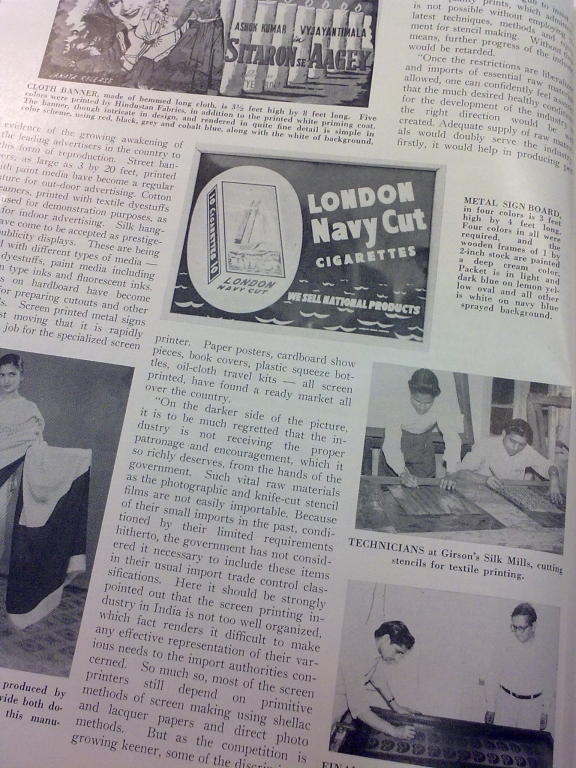Why do we pay so much attention to what goes on in India’s screen-printing industry? Is it the exotic nature of the country, its people, and its graphics? It is the fact that screen-printed goods must appeal to and satisfy such a huge population? Is it because the technologies and capabilities grow by leaps and bounds?
All of the above.
Why do we pay so much attention to what goes on in India’s screen-printing industry? Is it the exotic nature of the country, its people, and its graphics? It is the fact that screen-printed goods must appeal to and satisfy such a huge population? Is it because the technologies and capabilities grow by leaps and bounds?
All of the above.
Mike Young has been kind enough to document his travels to India and interactions with screen printers over there for Screen Printing for at least a half dozen years. And as good as his coverage is, those articles aren’t the first tour guides of India to grace the pages of this venerable publication. Consider the following excerpts from "Screen Printing in India," published in the May 1959 edition of Screen Process (the former title of Screen Printing), and compare them to snippets from Young’s observations in the August/September 2011 issue of Screen Printing.
Advertisement
1959
It may come as an agreeable surprise to screen printing people to find that in India, screen printing has advanced rapidly during the past few years, and that despite material and equipment shortages (in some cases, total non-availability), and an adverse condition of business secrecy which reminds us of similar "growing pains" in the industry in the United States, and probably in some other countries, screen printing has become a supplemental industry, developing both advertising and decorative wise.
In our trip through these plants in India, by way of their cooperation in furnishing publishable material for these pages, the economic importance of screen printing to the nation is amply brought out. It is also evident that despite the rapid growth of screen printing within the past three years or so, demand, rather than necessity of selling has forced the growth, literally lifting the industry in India by its own bootstraps….
It is only by producing high quality, and selling it after it is produced, according to the time-proven concepts of industry cooperation, rather than the maintenance of a wall of secrecy between competitors, who must face each other fairly and squarely, that the eventual dissolving of present restrictive conditions will be brought about by sheer weight of economic importance, in India, as it has been similarly experienced in other nations.
2011
The entire plant is effectively one huge clean room, save for the lobby/reception area, offices, cafeteria, and shipping department. The company proudly touts itself as the world’s largest screen printer of its type, and I have no qualms to the contrary from what I saw. Due to its enormous production capability to provide more than 15 million sets of automotive and graphic decals of all types annually, typically averaging five colors, it probably is the world’s biggest—period! It is certainly one of the most pleasant and organized screen-printing factories I have ever visited. The facility is laid out effectively for an optimized workflow in 130,000 sq ft of actual production space, although management claims they are running out of room quickly.
The plant boasts some of the most sophisticated, state-of-the-art collection of high-end printing machinery at varying automation levels, covering several sizes of flatbeds, cylinders, and roll-to-rolls to handle various substrates with either solvent or UV-based coatings. From my perspective, a similar thoughtfulness had apparently applied to their equally imposing fleet of pre-press processing equipment, as well as those to fully support their enormous post-printing operation―a wide range of finishing and fulfillment services—including a number of necessary quality-assurance requirements. In the case of their polyurethane doming operation, the company has one of the few worldwide hands-free, in-line, conveyorized doming lines, complete with robotic arms and multi-nozzle dispensing systems, to produce more than 200,000 domed labels in a single eight-hour shift.
The QA department works to guarantee long-lasting, high-quality, screen-printed products—particularly those that must conform to some of the world’s strictest automotive specifications. The team checks numerous physical and mechanical properties, in addition to durability when exposed to chemicals and atmospheric changes, which are simulated (accelerated), as required, either for days, weeks, or a number of years.
Advertisement


 Case Studies2 months ago
Case Studies2 months ago
 Art, Ad, or Alchemy2 months ago
Art, Ad, or Alchemy2 months ago
 Andy MacDougall2 months ago
Andy MacDougall2 months ago
 Columns3 weeks ago
Columns3 weeks ago
 Editor's Note2 weeks ago
Editor's Note2 weeks ago
 Thomas Trimingham2 months ago
Thomas Trimingham2 months ago
 Marshall Atkinson2 weeks ago
Marshall Atkinson2 weeks ago
 News & Trends1 month ago
News & Trends1 month ago
















